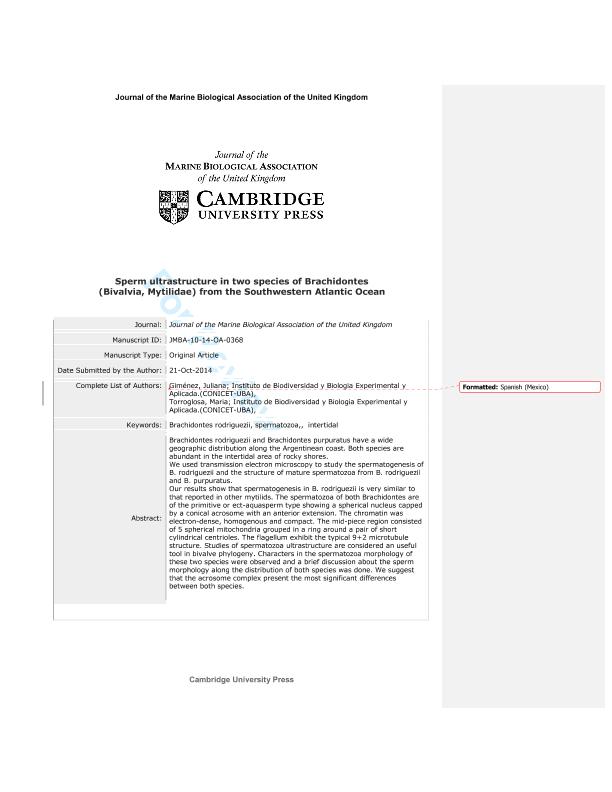Artículo
Sperm ultrastructure in two species of Brachidontes (Bivalvia, Mytilidae) from the south-western Atlantic Ocean
Fecha de publicación:
08/2015
Editorial:
Cambridge University Press
Revista:
Journal of the Marine Biological Association of the United Kingdom
ISSN:
0025-3154
e-ISSN:
1469-7769
Idioma:
Inglés
Tipo de recurso:
Artículo publicado
Clasificación temática:
Resumen
Brachidontes rodriguezii and Brachidontes purpuratus have a wide geographic distribution along the Argentinean coast. Both species are abundant in the intertidal area of rocky shores. We used transmission electron microscopy to study the spermatogenesis of B. rodriguezii and the structure of mature spermatozoa from B. rodriguezii and B. purpuratus. Our results show that spermatogenesis in B. rodriguezii is very similar to that reported in other mytilids. The spermatozoa of both Brachidontes are of the primitive or ect-aquasperm type showing a spherical nucleus capped by a conical acrosome with an anterior extension. The chromatin was electron-dense, homogeneous and compact. The mid-piece region consisted of 5 spherical mitochondria grouped in a ring around a pair of short cylindrical centrioles. The flagellum exhibit the typical 9 + 2 microtubule structure. Studies of spermatozoa ultrastructure are considered a useful tool in bivalve phylogeny. Characters in the spermatozoa morphology of these two species were observed and a brief discussion about the sperm morphology along the distribution of both species is presented. We suggest that the acrosome complex presents the most significant differences between both species.
Archivos asociados
Licencia
Identificadores
Colecciones
Articulos(IBBEA)
Articulos de INSTITUTO DE BIODIVERSIDAD Y BIOLOGIA EXPERIMENTAL Y APLICADA
Articulos de INSTITUTO DE BIODIVERSIDAD Y BIOLOGIA EXPERIMENTAL Y APLICADA
Citación
Torroglosa, Maria Eugenia; Giménez, Juliana; Sperm ultrastructure in two species of Brachidontes (Bivalvia, Mytilidae) from the south-western Atlantic Ocean; Cambridge University Press; Journal of the Marine Biological Association of the United Kingdom; 95; 5; 8-2015; 991-998
Compartir
Altmétricas




